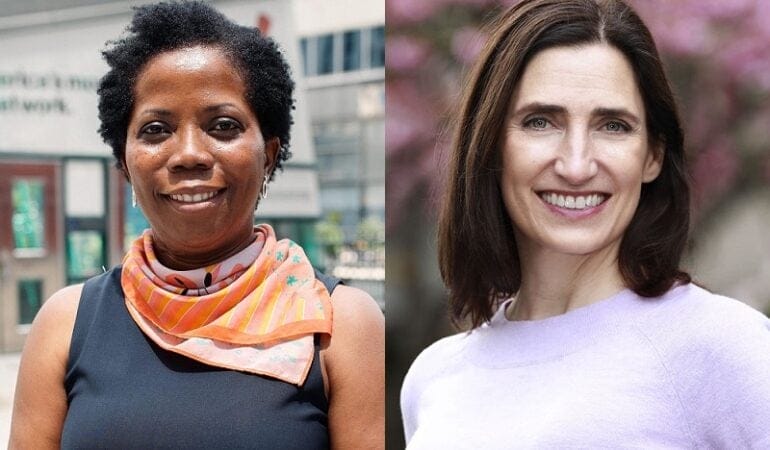
Land Matters Podcast: Addressing Structural Racism in Urban Planning
City planners are emerging from behind the scenes to help address some of society’s most complex challenges, including building equity and fighting racism. This summer a coalition of planners came together to acknowledge past discrimination in urban development policies and commit to becoming “change agents” to help create more racially equitable communities.
The new approach starts with a better community engagement process, says Eleanor Sharpe, executive director at the Philadelphia City Planning Commission and a coauthor of the newly released Commitment to Change. Sharpe is one of 20 urban planners across the United States who have signed the statement; the group is inviting other planning directors, in cities and towns of all sizes, to sign on.
Sharpe joined Andrea Durbin, director of planning and sustainability for the city of Portland, Oregon, and a fellow signatory, on Land Matters, the podcast of the Lincoln Institute of Land Policy.
Sharpe and her colleagues have embraced the idea of “moving at the speed of trust,” she says, describing the process as “very slow, very intentional, very careful listening, hearing, learning. . . . We want to amplify the lived experience of the people, and that this is not just solely professional planners who are making determinations.”

The planners’ initiative is part of a reckoning about structural racism in American society—economic forces, institutions, and interactions that have discrimination baked in. That includes buying a home, for example, because of racial covenants and the practice of redlining, which saw federal lending guidelines deny loans to those in neighborhoods with people of color or immigrants. Such policies denied the wealth that comes with homeownership—an impact felt over generations.
Governments implemented other harmful policies: the bulldozing of Black neighborhoods during the time of urban renewal; plowing freeways through those same neighborhoods, casting shadows and blighting everything nearby; setting zoning to favor the white and wealthy in single-family homes; and designing poor-quality public housing in isolated locations.
The harsh treatment of these communities “wasn’t an afterthought,” said Sharpe. “It was deliberate.”
Although city planners were not directly or solely responsible for each of those decisions, the planning profession has been in some ways complicit in setting the stage for racial segregation, according to the planners’ statement.
“We’ve seen the impacts of past policies across our nation,” says Durbin. “The planning directors that we’re working with are coming together and saying . . . that we need to recognize that, we need to own that, acknowledge it, and make changes.”

Joining several other cities, Portland recently banned zoning that allows only single-family houses, opening the way for more affordable multi-family housing in prime neighborhoods. “Our first zoning code was adopted in 1924, and back then, single-family zoning was applied to the 15 highest quality neighborhoods . . . embedding exclusionary practices into our zoning policies from the very beginning,” Durbin says. “These are areas that are near transit and other key amenities, good schools. We needed to provide more [housing] choices for our residents.”
This kind of work can be fraught. Cities that change zoning to encourage more housing development, or take advantage of federal funding to dismantle urban freeways, face the specter of fueling gentrification.
“This is the ultimate conundrum, especially in cities that have challenging areas of poverty and disenfranchisement—the fear [that] any improvement will result in a completely new population moving in, displacing the existing population, some of whom have lived in these areas through all its challenges,” Sharpe says.
The planners acknowledge they are stepping out with more prominence than has generally been the case for the profession, but they say the moment calls for a new approach.
“We just need to flip the script,” says Durbin. “The question is, how do we use our tools, land use planning, zoning tools to advance racial equity, build community wealth, increase economic opportunities for Black, Indigenous, and communities of color? We need to be intentional about who benefits, who’s burdened, and ensure that community benefits and public good are centered in our planning processes, and that we’re planning for those who’ve been most underserved.”
The new initiative emerged from a network of planners from major U.S. cities, who convene each year to exchange ideas, with facilitation by the Lincoln Institute, the American Planning Association, and the Harvard University Graduate School of Design. In this 75th anniversary year—the Lincoln Institute started as the Lincoln Foundation in 1946—the Lincoln Institute is exploring how this program and others have evolved over the years, and how they are being applied now to some of the world’s most pressing challenges.
You can listen to the show and subscribe to Land Matters on Apple Podcasts, Google Podcasts, Spotify, Stitcher, or wherever you listen to podcasts.
Anthony Flint is a senior fellow at the Lincoln Institute of Land Policy, host of the Land Matters podcast, and a contributing editor of Land Lines.
Lead Photograph: Eleanor Sharpe, executive director at the Philadelphia City Planning Commission. Credit: Altamira Film Co.
Related Content
Reimagine Philadelphia Steering Committee Begins Work
Portland 2035 Comprehensive Plan
Portland’s Residential Infill Project
History of Racist Planning in Portland
American Planning Association, Equity Diversity Inclusion
Land Lines: Think Land Policy Is Unrelated to Racial Injustice? Think Again.
Land Lines: Race and Rezoning: Louisville Designs a More Equitable Future by Confronting the Past
CityLab: What It Looks Like to Reconnect Black Communities Torn Apart by Highways
